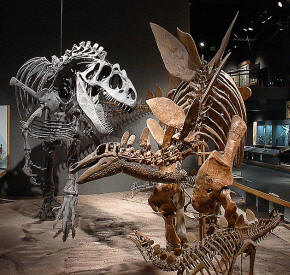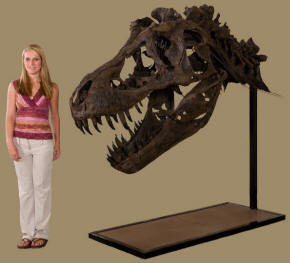
Old Earth Ministries Online Dinosaur CurriculumFree online curriculum for homeschools and private schoolsFrom Old Earth Ministries NOTE: If you found this page through a search engine, please visit the intro page first.
|
Lesson 1 - Introduction |
|
The Dinosaur Curriculum Homepage contains the table of contents. Please bookmark this page, as you will need it for navigating to the next lesson. The curriculum is broken down into sections, based on dinosaur types, and their relationships with each other. Pictures in this curriculum are either public domain (in which there will be no "Picture Source" link), or they are allowed to be used as long as the original picture owner is acknowledged. This acknowledgement is done throu the "Picture Source" link, which will take you to the web page that contains the original picture. In addition to the pictures, some lessons will have video lessons. These video links are provided to enhance your learning experience, however, no test questions will come from the videos. For testing purposes, you will see many size estimates for dinosaurs listed in the text. At the beginning of each dinosaur lesson, there will be a grey text box, like the one you see above, listing general characteristics of the dinosaur. The figures inside these grey boxes are the ones the test questions are based on. Speaking of tests, it is recommended that the tests be taken 'open book' (although this will be up to your teacher). While some questions will be easy, others may require more effort to find the answers. Ready to begin? Let's get started! What Is a Dinosaur? Dinosaurs were the dominant terrestrial vertebrate animals for over 160 million years, from the late Triassic period (about 230 million years ago) until the end of the Cretaceous period (about 65 million years ago), when the Cretaceous–Tertiary extinction event caused the extinction of most dinosaur species. Many scientists, including many Christians, believe that the fossil record indicates that birds evolved from theropod dinosaurs during the Jurassic period, and most paleontologists regard them as the only clade of dinosaurs to have survived until the present day. Dinosaurs were a varied group of animals. Paleontologists have identified over 500 distinct genera and more than 1,000 different species of dinosaur, and remains have been found on every continent on Earth. (These numbers change, depending on who you ask! In fact, a recent count shows that scientists have named 965 genera). Some dinosaurs were herbivorous, eating only plants, while others were carnivorous, eating meat. Some species are regarded as omnivorous, eating both plants and meat. Some were bipedal, others quadrupedal, and others were able to shift between these body postures. Many species developed elaborate skeletal modifications such as bony armor, horns or crests. Although generally known for their large size, many dinosaurs were human-sized or even smaller. Most major groups of dinosaurs are known to have built nests and laid eggs, suggesting an oviparity similar to that of modern birds. The term "dinosaur" was coined in 1842 by Sir Richard Owen and derives from Greek δεινός (deinos) "terrible, powerful, wondrous" + σαῦρος (sauros) "lizard". Through the first half of the twentieth century, most of the scientific community believed dinosaurs to have been sluggish, unintelligent cold-blooded animals. Most research conducted since the 1970s, however, has indicated that dinosaurs were active animals with elevated metabolisms and numerous adaptations for social interaction. Since the first dinosaur fossils were recognized in the early nineteenth century, mounted dinosaur skeletons have been major attractions at museums around the world, and dinosaurs have become a part of world culture. They have been featured in best-selling books and films such as Jurassic Park, and new discoveries are regularly covered by the media. As a result, the word "dinosaur" has entered the vernacular, although its use and meaning in colloquial speech may be inconsistent with modern science. In English, for example, "dinosaur" is commonly used to describe anything that is impractically large, slow-moving, obsolete, or bound for extinction. Distinguishing anatomical features While recent discoveries have made it more difficult to present a universally agreed-upon list of dinosaurs' distinguishing features, nearly all dinosaurs discovered so far share certain modifications to the ancestral archosaurian skeleton. Although some later groups of dinosaurs featured further modified versions of these traits, they are considered typical across Dinosauria; the earliest dinosaurs had them and passed them on to all their descendants. Such common features across a taxonomic group are called synapomorphies. Dinosaur synapomorphies include an elongated crest on the humerus, or upper arm bone, to accommodate the attachment of deltopectoral muscles; a shelf at the rear of the ilium, or main hip bone; a tibia, or shin bone, featuring a broad lower edge and a flange pointing out and to the rear; and an ascending projection on the astragalus, one of the ankle bones, which secures it to the tibia. A variety of other skeletal features were shared by many dinosaurs. However, because they were either common to other groups of archosaurs or were not present in all early dinosaurs, these features are not considered to be synapomorphies. For example, as diapsid reptiles, dinosaurs ancestrally had two pairs of temporal fenestrae (openings in the skull behind the eyes), and as members of the diapsid group Archosauria, had additional openings in the snout and lower jaw. Additionally, several characteristics once thought to be synapomorphies are now known to have appeared before dinosaurs, or were absent in the earliest dinosaurs and independently evolved by different dinosaur groups. These include an elongated scapula, or shoulder blade; a sacrum composed of three or more fused vertebrae (three are found in some other archosaurs, but only two are found in Herrerasaurus); and an acetabulum, or hip socket, with a hole at the center of its inside surface (closed in Saturnalia, for example). Another difficulty of determining distinctly dinosaurian features is that early dinosaurs and other archosaurs from the Late Triassic are often poorly known and were similar in many ways; these animals have sometimes been misidentified in the literature. Dinosaurs stood erect in a manner similar to most modern mammals, but distinct from most other reptiles, whose limbs sprawl out to either side. Their posture was due to the development of a laterally facing recess in the pelvis (usually an open socket) and a corresponding inwardly facing distinct head on the femur. Their erect posture enabled dinosaurs to breathe easily while moving, which likely permitted stamina and activity levels that surpassed those of "sprawling" reptiles. Erect limbs probably also helped support the evolution of large size by reducing bending stresses on limbs. Some non-dinosaurian archosaurs, including rauisuchians, also had erect limbs but achieved this by a "pillar erect" configuration of the hip joint, where instead of having a projection from the femur insert on a socket on the hip, the upper pelvic bone was rotated to form an overhanging shelf. Dinosaurs are divided into two distinct groups. Saurischia from the Greek sauros meaning 'lizard' and ischion meaning 'hip joint') is one of the two orders, or basic divisions, of dinosaurs. In 1888, Harry Seeley classified dinosaurs into two orders, based on their hip structure. Saurischians ('lizard-hipped') are distinguished from the ornithischians ('bird-hipped') by retaining the ancestral configuration of bones in the hip. All carnivorous dinosaurs (the theropods) are saurischians, as are one of the two primary lineages of herbivorous dinosaurs, the sauropodomorphs. The second is the Ornithischia order of beaked, herbivorous dinosaurs. The name ornithischia is derived from the Greek ornitheos meaning 'of a bird' and ischion meaning 'hip joint'. They are known as the 'bird-hipped' dinosaurs because of their bird-like hip structure, even though birds actually descended from the 'lizard-hipped' dinosaurs (the saurischians). Being herbivores that sometimes lived in herds, they were more numerous than the saurischians. They were prey animals for the theropods and were smaller than the sauropods. What Is Not a Dinosaur? There are several popular species that existed during the time of the dinosaurs that are often mistaken for dinosaurs. Plesiosaurs, the great sea creatures, and the great flyers, the pterodons, are fascinating, but they are not dinosaurs. Even though they are not dinosaurs, they are popular creatures to study, and we will examine these creatures in the last few lessons of this curriculum. Shopping At the bottom of each dinosaur lesson, there may be a section called Shopping. If
Bay State Replicas - T-rex teeth, claws, skulls, jaws, foot, rib, femur, complete skeleton (1/20 scale), brain cavity Black Hills Institute - Full size skulls, skeletons, 1/6th scale disartictulated skull, teeth, arm, leg, femur, foot, claws. Wall-mounted half-skull. End of Reading
Return to the Old Earth Ministries Online Dinosaur Curriculum homepage.
|

